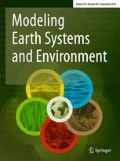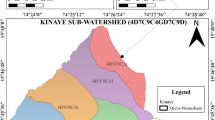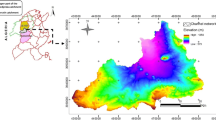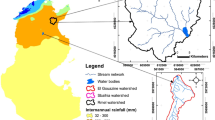Abstract
In Morocco, several major development projects have been planned to address the worrying concern for soil and water resources. They aimed to reduce the soil degradation and loss of soil fertility caused mainly by water erosion, deforestation, and agricultural practices. The objective of this work is the quantification of the water balance and soil erosion and its spatial distribution, using the hydro-agricultural SWAT model, followed by the evaluation of the best management practices (BMPs) at the M’dez basin (3350 km2), such as contour tillage, bench terraces, and stone line. The coefficient of determination (R2) and Nash–Sutcliffe values were both 0.65 during the calibration step (1993–2002) and 0.56 and 0.61 (2003–2013), respectively, during the validation step, indicating satisfactory performance of the SWAT simulation. The water balance established at the M’dez watershed level shows that the average annual rainfall was around 382 mm, of which 79.9% was lost by evapotranspiration (300.05 mm). Surface runoff was about 13.83 mm, corresponding to 3.6% of precipitation. The results of the implementation of BMPs in agricultural areas showed that the contour tillage scenario was the most efficient option, with a contribution of baseflow to the surface flow of about 7.8%, and an infiltration into the groundwater of approximately 48.2%, which means better preservation of surface water resources. For soil losses, the reduction was significant at 64.90%. At watershed level, the tillage contour scenario coupled with a forestation strategy of the most degraded sub-basins (Slope < 25%) reduced the annual average specific degradation from 3.95 to 1.57 t/ha/year, i.e. (60.25%), and decrease the mean annual sediment input by 60.25% compared to the baseline scenario. The siltation rate of the projected M’dez retention dam was estimated at 0.8 Mm3/year for the baseline scenario, and was reduced to 0.78 Mm3/year and 0.34 Mm3/year, respectively, for the contour tillage scenario and its coupling with the forestation strategy. This work has shown that hydrological modeling using SWAT coupled with BMPs will help planners to manage water and soil resources in an integrated manner at the watershed scale. It will also provide useful information and effectively target the best water and soil conservation practices to select the most appropriate practice for agricultural watersheds.

















Similar content being viewed by others
References
Abbaspour K, Yang J, Maximov I, Siber R, Bogner K, Mieleitner J, Zobrist J, Srinivasan R (2007) Modeling hydrology and water quality in the pre-alpine/alpine Thur watershed using SWAT. J Hydrol 333:413–430
Abbaspour KC, Rouholahnejad E, Vaghefi S, Srinivasan R, Yang H, Klove B (2015) A continental-scale hydrology and water quality model for Europe: calibration and uncertainty of a high-resolution large-scale SWAT model. J Hydrol 524:733–752
Abbott MB, Bathurst JC, Cunge JA, O’Connell PE, Rasmussen J (1986) An introductivn to the European Hydrological System—Syscme Hydrologique Europen, “SHE”, 1. His’.ory and philc, sophy of a physically-based, distributed modelling system. J Hydrol 87:45–59
Adam M et al (2019) Multi-scale hydrologic sensitivity to climatic and anthropogenic changes in Northern Morocco. Geosciences 2020(10):13
Ahl RS, Woods SW, Zuuring HR (2008) Hydrologic calibration and validation of SWAT in a snow-dominated Rocky Mountain watershed, Montana, USA. J Am Water Resour Assoc 44(6):1411–1430
Ahmadi M, Minaei M, Ebrahimi O et al (2020) Evaluation of WEPP and EPM for improved predictions of soil erosion in mountainous watersheds: a case study of Kangir River basin, Iran. Model Earth Syst Environ 6:2303–2315. https://doi.org/10.1007/s40808-020-00814-w
Allen RG, Tasumi M, Trezza R (2007) Satellite-based energy balance for mapping evapotranspiration with internalized calibration (METRIC)—model. ASCE J Irrig Drain Eng 133(4):380–394
Ananda J, Herath G (2003) Soil erosion in developing countries: a socio-eco-nomic appraisal. J Environ Manage 68:343–353
Arabi M, Frankenberger JR, Engel BA, Arnold JG (2008) Representation of agricultural conservation practices with SWAT. Hydrol Process 22(16):3042–3055
Arnold JG, Williams JR, Srinivasan R, King KW (1996) SWAT: soil and water assessment tool. USDA-ARS, Grassland, Soil and Water Research Laboratory, Temple
Arnold JG, Srinivasan R, Muttiah RS, Williams JR (1998) Large area hydrologic modeling and assessment part 1: model development. J Am Water Resour Assoc 34(1):73–89
Arnold JG, Kiniry JR, Srinivasan R, Williams JR, Haney EB, and Neitsch SL (2012a) Soil and water assessment tool, input/output file documentation, version 2012. Texas Water Research Institute. Technical Report 439, College Station
Arnold JG, Moriasi DN, Gassman PW, Abbaspour KC, White MJ, Srinivasan R et al (2012b) SWAT: model use, calibration, and validation. Trans ASABE 55(4):1491–1508
Baker TJ, Miller SN (2013) Using the soil and water assessment tool (SWAT) to assess land use impact on water resources in an East African watershed. J Hydrol 486:100–111
Bastiaanssen WGM, Noordman EJM, Pelgrum H, Davids G, Thoreson BP, Allen RG (2005) SEBAL model with remotely sensed data to improve water-resources management under actual field conditions. J Irrig Drain Eng 131:85–93
Beasley DB, Hyggins LF (1995) ANSWERS user’s manual. U.S. Environmental Protection Agency, Chicago
Betrie GD, Mohamed YA, Van Griensven A, Srinivasan R (2011) Sediment management modeling in the Blue Nile Basin using the SWAT model. Hydrol Earth Syst Sci 15:807–818
Beven KJ (2011) Rainfall–runoff modelling: the primer, 2nd edn. Wiley, Hoboken
Boardman J, Shepheard ML, Walker E, Foster IDL (2009) Soil erosion and risk assessment for on- and off-farm impacts: a test case using the Midhurst area, West Sussex, UK. J Environ Manage 90:2578–2588
Boufala M, El Hmaidi A, Chadli K, Essahlaoui A, El Ouali A, Taia S (2019) Hydrological modeling of water and soil resources in the basin upstream of the Allal El Fassi dam (Upper Sebou watershed. Model Earth Syst Environ. https://doi.org/10.1007/s40808-019-00621-y
Boufala M, El Hmaidi A, Chadli K, Essahlaoui A, El Ouali A (2020) E3S web of conferences 150,03014(2020). https://doi.org/10.1051/e3sconf/202015003014
Briak H, Mrabet R, Moussadek R, Aboumaria K (2019) Use of a calibrated SWAT model to evaluate the effects of agricultural BMPs on sediments of the Kalaya river basin (North of Morocco). Int Soil Water Conserv Res. https://doi.org/10.1016/j.iswcr.2019.02.002
Chadli K, Boufala M (2021) Assessment of water quality using Moroccan WQI and multivariate statistics in the Sebou watershed (Morocco). Arab J Geosci 14:27. https://doi.org/10.1007/s12517-020-06296-5
Dawadi S, Ahmad S (2013) Evaluating the impact of demand-side management on water resources under changing climatic conditions and increasing population. J Environ Manag 114:261–275
Dechmi F, Skhiri A (2013) Evaluation of best management practices under intensive irrigation using the SWAT model. Agric Water Manag 123:55–64
DeNicola E, Aburizaiza OS, Siddique A, Khwaja H, Carpenter DO (2015) Climate change and water scarcity: the case of Saudi Arabia. Ann Glob Health 81(3):342–353
Di Luzio M, Srinivasan R, Arnold JG, Neitsch SL (2002) Soil and water assessment tool. ArcView GIS interface manual: version 2000. GSWRL Report 02-03, BRC Report 02-07. Texas Water Resources Institute, College Station, p 346. https://doi.org/10.3390/geosciences10010013
FAO (2015) Global soil status, processes, and trends. Status of the World’s Soil Resources (SWSR) Main Report of the Food and Agriculture Organization, New York, United Nations
Forsee WJ, Ahmad S (2011) Evaluating urban storm water infrastructure design in response to projected climate change. J Hydrol Eng 16(11):865–873
Frederick KD, Major DC (1997) Climate change and water resources. Clim Chang 37(1):7–23
Gitau MW, Chaubey I (2010) Regionalization of SWAT model parameters for use in ungauged watersheds. Water 2(25):849–871. https://doi.org/10.3390/w2040849,2010
Githui F, Selle B, Thayalakumaran T (2011) Recharge estimation using remotely sensed evapotranspiration in an irrigated catchment in southeast Australia. Hydrol Process 26:1379–1389. https://doi.org/10.1002/hyp.8274
Green Water Credits (2010) Proof-of-Concept, Sebou catchment (Project Sebou Eau Vert). Work Plan. Draft
Gyamfi C, Ndambuki JM, Anornu GK et al (2017) Groundwater recharge modelling in a large scale basin: an example using the SWAT hydrologic model. Model Earth Syst Environ 3:1361–1369. https://doi.org/10.1007/s40808-017-0383-z
Halefom A, Sisay E, Khare D et al (2017) Hydrological modeling of urban catchment using semi-distributed model. Model Earth Syst Environ 3:683–692. https://doi.org/10.1007/s40808-017-0327-7
Hargreaves G, Samani Z (1985) Reference crop evapotranspiration from temperature. Appl Eng Agric 1(2):96–99
Haverkamp S, Fohrer N, Frede HG (2005) Assessment of the effect of land use patterns on hydrologic landscape functions: a comprehensive GIS-based tool to minimize model uncertainty resulting from spatial aggregation. Hydrol Process 19(3):715–727
Hazan R, Lazarevic D (1965) Hydrologie en zone karstique au Maroc: Sebou—Beth. Pub. Annuaires Hydrol. Maroc 1962-1963 et Actes Coll. hydrol. roches fissurées. Dubrovnik 1965. publi. 1967. Ass. Int. Hydrol Sci UNESCO Paris 1967:275–292
Hirt C, Filmer MS, Featherstone WE (2010) Comparison and validation of recent freely available ASTER-GDEM ver1, STRM ver4.1 and GEODATA DEM-9S ver3 digital elevation models over Australia. Austral J Earth Sci 57(3):337–347. https://doi.org/10.1007/s11368-019-02443-y
Immerzeel WW, Droogers P (2008) Calibration of a distributed hydrological model based on satellite evapotranspiration. J Hydrol 349:411–424. https://doi.org/10.1016/j.jhydrol.2007.11.017
Karrat L, ElouadeiheK Brehert JG, Hessane MA (2016) Erosion et matières transportées en suspension dans le bassin versant de l’Oued Sebou en amont du barrage Allal Fassi (Moyen Atlas, Maroc). Revue Marocaine de Géomorphologie, Numéro 1:47–61
Makwana JJ, Tiwari MK (2017) Hydrological stream flow modelling using soil and water assessment tool (SWAT) and neural networks (NNs) for the Limkheda watershed, Gujarat, India. Model Earth Syst Environ 3:635–645. https://doi.org/10.1007/s40808-017-0323-y
Monteith JL (1965) Evaporation and the environment. The state and movement of water in living organisms. In: XIXth Symposium. Soc. for Exp. Biol., Swansea. Cambridge University Press, pp 205–234
Moriasi DN, Arnold JG, Van Liew MW, Bingner RL, Harmel RD, Veith TL (2007) Model evaluation guidelines for systematic quantification of accuracy in watershed simulations. Trans ASABE 50(3):885–900
Mosbahi M, Benabdallah S (2019) Assessment of land management practices on soil erosion using SWAT model in a Tunisian semi-arid catchment. J Soils Sedim
Moss B (2008) Water pollution by agriculture. Philos Trans R Soc B 363:659–666
Naciri S, Ansari H, Ziaei AN (2020) Simulation of water balance equation components using SWAT model in Samalqan Watershed (Iran). Arab J Geosci 13:421. https://doi.org/10.1007/s12517-020-05366-y
Ndomba PM, Van Griensven A (2011) Suitability of SWAT model for sediment yields modeling in eastern Africa, advances in data, methods, models and their applications in geoscience. Technical Paper. University of Dares Salam, Dares Salaam, Tanzania
Neitsch SL, Arnold JG, Kiniry JR, William JR (2005) Soil and water assessment tool theoretical documentation, version 2005. In: Grassland, Soil, and Water Research Laboratory—Agricultural Research Service. Blackland Research Center—Texas Agricultural Experiment Station, p 494
Neitsch SL, Arnold JG, Kiniry JR, Williams JR, King KW (2011) Soil and water assessment tool—theoretical documentation— version 2009. Grassland, Soil, and Water Research Laboratory, Agricultural Research Service and Blackland Research Center, Texas Agricultural Experiment Station, Temple, Texas
Paul M (2016) Impacts of land use and climate changes on hydrological processes in South Dakota Watersheds
Paul M, Negahban-Azar M (2018) Sensitivity and uncertainty analysis for streamflow prediction using multiple optimization algorithms and objective functions: san Joaquin Watershed, California. Model Earth Syst Environ 4:1509–1525. https://doi.org/10.1007/s40808-018-0483-4
Paul M, Rajib MA, Ahiablame L (2017) Spatial and temporal evaluation of hydrological response to climate and land use change in three South Dakota watersheds. JAWRA 53:69–88
Ramos MC, Benito C, Martínez-Casasnovas JA (2015) Simulating soil conservation measures to control soil and nutrient losses in a small, vineyard dominated, basin. Agric Ecosyst Environ 213:194–208
Schilling J, Freier KP, Hertig E, Scheffran J (2012) Climate change, vulnerability and adaptation in North Africa with focus on Morocco. Agric Ecosyst Environ 156:12–26
SCS (1972) Sect. 4: hydrology In National Engineering Handbook. SCS
Setegn GS, Srinivasan R, Dargahi B (2008) Hydrological modeling in the Lake Tana Basin, Ethiopia using the SWAT model. Open Hydrol J 2(1)
Shao W, Cai J, Liu J, Luan Q, Mao X, Yang G, Wang J, Zhang H, Zhang J (2017) Impact of water scarcity on the Fenhe River Basin and Mitigation Strategies. Water 9:30
Sisay E, Halefom A, Khare D et al (2017) Hydrological modelling of ungauged urban watershed using SWAT model. Model Earth Syst Environ 3:693–702. https://doi.org/10.1007/s40808-017-0328-6
Strauch M, Volk M (2013) SWAT plant growth modification for improved modeling of perennial vegetation in the tropics. Ecol Model 269:98–112. https://doi.org/10.1016/j.ecolmodel.2013.08.013
Su Z (2002) The Surface Energy Balance System (SEBS) for estimation of turbulent heat fluxes. Hydrol Earth Syst Sci 6(1):85–100
Terink W, Hunink J, Droogers P, Reuter H, Van Lynden G, Kaufman S (2011) Green water credits Morocco: inception phase. Impacts of land management options in the Sebou Basin: using the soil water and assessment tool—SWAT. In: Green Water Credits Report M1. Future Water Report 101
Tuppad P, Douglas-Mankin KR, Lee T, Srinivasan R, Arnold JG (2011) Soil and Water Assessment Tool (SWAT) hydrologic/water quality model: extended capability and wider adoption. Trans ASABE 54(5):1677–1684
USAID (2010) The Middle East and North Africa Water Center Network. USAID, Washington, DC
Vörösmary CJ, Green P, Salisbury J, Lammers RB (2000) Global water resources: vulnerability from climate change and population growth. Science 289(5477):284–288
Wang R, Bowling LC, Cherkauer KA (2016) Estimation of the effects of climate variability on crop yield in the Midwest USA. Agric For Meteorol 216:141–156
Williams JR (1995) Chapter 25. The EPIC Model. In: Computer models of watershed hydrology. Water Resources Publications. Highlands Ranch, pp 909–1000
Yang Q, Zhao Z, Benoy G, Chow TL, Rees HW, Bourque CPA, Meng FR (2010) A watershed-scale assessment of the cost-effectiveness of sediment abatement with flow diversion terraces. J Environ Qual 39:220
Zettam A, Taleb A, Sauvage S, Boithias L, Belaidi N, Sánchez-Pérez J (2017) Modeling hydrology and sediment transport in a semi-arid and anthropized catchment using the SWAT model: the case of the Tafna river (northwest Algeria). Water 9:216
Author information
Authors and Affiliations
Corresponding author
Additional information
Publisher's Note
Springer Nature remains neutral with regard to jurisdictional claims in published maps and institutional affiliations.
Rights and permissions
About this article
Cite this article
Boufala, M., El Hmaidi, A., Essahlaoui, A. et al. Assessment of the best management practices under a semi-arid basin using SWAT model (case of M’dez watershed, Morocco). Model. Earth Syst. Environ. 8, 713–731 (2022). https://doi.org/10.1007/s40808-021-01123-6
Received:
Accepted:
Published:
Issue Date:
DOI: https://doi.org/10.1007/s40808-021-01123-6




